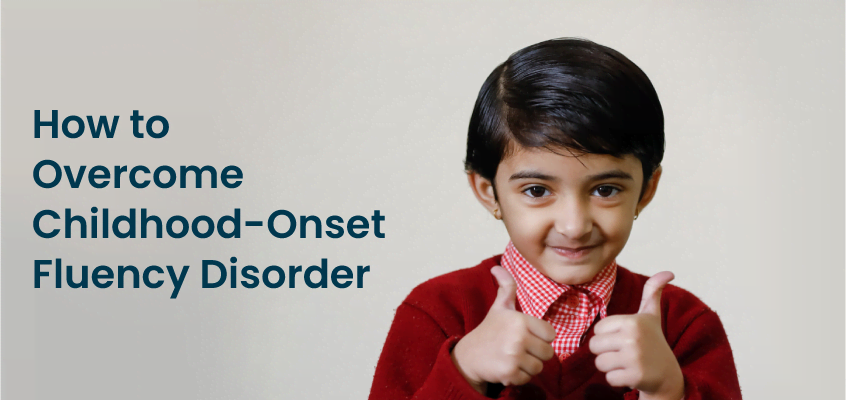Introduction
A childhood-onset fluency disorder[1] is when an individual begins to stutter, repeat sounds, syllables, and words, or prolong certain sounds. Individuals with this condition know what they want to say but struggle to translate their thoughts into words.
The average age of onset for this disorder is 2 to 7 years. Although the condition can last for life, close to 65-85% of children fully recover. This guide will teach more about this disorder and what you can do to overcome it.
What is childhood-onset fluency disorder?
A childhood-onset fluency disorder[2] is a condition that affects the timing and flow of an individual’s speech. It is also commonly known as stuttering[3].
An individual with this condition typically tends to prolong and repeat speech sounds. Individuals suffering from this disorder also often hesitate while speaking or otherwise, and they face abnormal stress trying to achieve the desired words and pauses.
It usually includes speaking-related anxiety in individuals and limits their comfort level in external environments like social or academic settings.
Signs and symptoms of childhood-onset fluency disorder
Stuttering is commonly found in children as they are still learning to speak. However, this can develop into a disorder if it persists for a long time. The symptoms of this disorder typically develop between 2 to 7 years of age. Stuttering occurs more in boys as compared to girls.
Here are the signs and symptoms[4] of childhood-onset fluency disorder:
-
Repetition of sounds, monosyllabic words, or syllables
-
Vocalizing consonants and vowels for prolonged periods
-
Broken words
-
Unfilled pauses as part of speech
-
Other words replace problematic words
-
Physical tension like fist-clenching or head-jerking while speaking
-
Speech-related embarrassment or frustration
-
Start of intellectual and adaptive incompetency
The symptoms of a childhood-onset fluency disorder can appear or disappear based on the task, according to the fifth edition of the Diagnostic and Statistical Manual of Mental Disorders (DSM-5). For instance, an individual may not face speech issues while singing or reading but cannot initiate a conversation without stuttering. Similarly, an individual may start stuttering in a tense situation. Anxiety, stress, and self-consciousness can potentially increase the severity of the symptoms of a childhood-onset fluency disorder.
Causes of childhood-onset fluency disorder
According to a study published in 2019[5], childhood-onset fluency disorder affects around 5-10% of preschool children in the U.S. However, most individuals recover from the condition, with research suggesting that only 1% of the adult population in the U.S. continue to experience this disorder for life.
The mismatch between the flow and timing of speech in childhood-onset fluency disorder is mainly related to various motor, linguistic, neural, and emotional factors that can cause abnormalities in different parts of the brain. The symptoms can worsen if the individual feels nervous, distressed, or under pressure.
It is critical to differentiate between childhood-onset fluency disorder and dysfluencies caused by other reasons. For instance, brain or stroke injuries can also cause speech problems. Similarly, certain medications and Tourette’s syndrome can also cause problems with speech. Clinicians usually rule out other possible causes before diagnosing a patient with a childhood-onset fluency disorder.
The following factors are:
Biological Factors
Family history of communication disorders, developmental delays, and other related speech disorders are one of the critical causes of a childhood-onset fluency disorder. These are the key biological factors that can cause stuttering in a child.
Psychological Factors
Neurological issues with motion control in speech can cause childhood-onset fluency disorder. At the same time, other psychological factors like anxiety and depression can also cause this communication disorder.
Environmental Factors
High stress in the home environment can also lead to childhood-onset fluency disorder.
Treatment of childhood-onset fluency disorder
A professional speech-language pathologist can diagnose and treat childhood-onset fluency disorder. The treatment options focus on reducing or eliminating the issues in speech fluency. They also cover helping individuals improve communication and participation in social environments like school and work.
Speech therapy is one of the most popular treatments for this disorder. Psychologists use electronic devices such as delayed auditory feedback tools to improve speech fluency. Doctors also use cognitive-behavioural therapy to identify the reasons behind the stuttering and to help manage anxiety or stress caused by stuttering.
Psychologists also use an improved communication framework between parents and children with this disorder to help individuals cope with their stuttering. Most children who develop this disorder symptoms recover from the disease as they age. Assessing the severity of a child’s signs by the time they are eight years old will help gauge their recovery potential.
Conclusion
Most people do not consider stuttering a medical condition; not everyone opts for treatment. For example, although treatments are available for this disorder, some people think it is a personality trait. These people usually also try to build a culture of solidarity and acceptance for individuals with this disorder, thus limiting the options for recovery.
Childhood-onset fluency disorder can significantly affect an individual’s mental state and leave them with low self-esteem and self-confidence. Helping the individual with the available treatment options is better than acceptance. Visit us at United We Care to access professional mental help for this disorder from the comfort of your home!
References
[1] J. A. Tetnowski, K. S. Scott, and B. F. Rutland, “Fluency and fluency disorders,” The Handbook of Language and Speech Disorders. Wiley, pp. 414–444, Mar-2021.
[2] An Informational Handout, “Childhood-onset fluency disorder (stuttering),” 142.34.196. [Online]. Available: http://136.142.34.196/files/pdf/BirsteinInfoHandoutStuttering05282015.docx.pdf. [Accessed: 03-Mar-2023]
[3] “Childhood-onset fluency disorder,” Psychology Today.
[4] “Stuttering,” Mayo Clinic, 05-Jun-2021. [Online]. Available: https://www.mayoclinic.org/diseases-conditions/stuttering/symptoms-causes/syc-20353572. [Accessed: 03-Mar-2023].
[5] R. W. Sander and C. A. Osborne, “Stuttering: Understanding and treating a common disability,” Am. Fam. Physician, vol. 100, no. 9, pp. 556–560, 2019.





